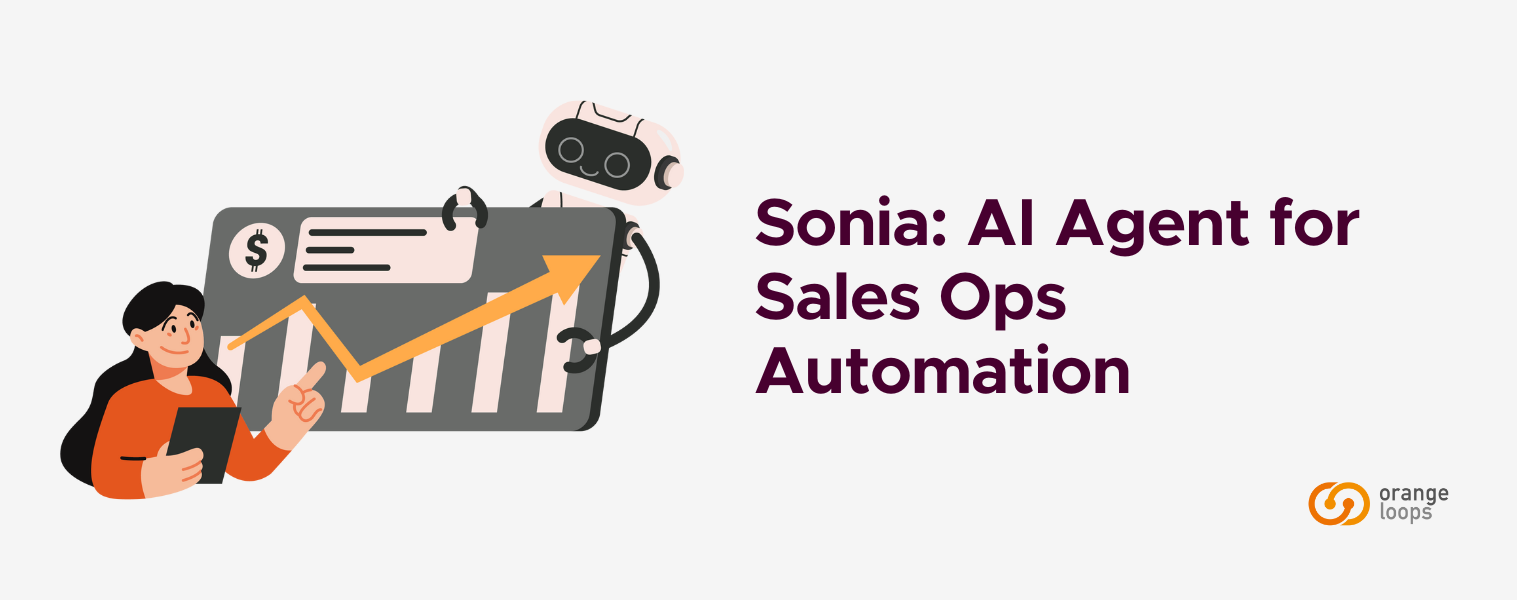
Introduction
Before Sonia, the sales and pre‑sales crew at Orangeloops spent precious hours every week on chores such as:
- Hunting across dozens of websites for potential projects.
- Copy‑pasting deal details into HubSpot and chasing stage updates.
- Crafting effort spreadsheets for each prospect from scratch.
- Assembling slide decks to explain scope, costs and next steps.
- Sending endless Slack pings to gather missing information.
These activities are essential yet repetitive, leaving little room for strategic thinking. Sonia automates that busywork so people can focus on relationship‑building and creative problem‑solving.
Our solution
Sonia is an artificial‑intelligence agent designed at Orangeloops to shoulder the operational load that slows down sales and pre‑sales teams. Today Sonia can:
- Estimate project effort using context such as sprint count, team allocation, QA percentage and more.
- Generate client‑ready PowerPoint decks that frame the client’s challenge and outline tailored solutions (text placeholders only).
- Work with HubSpot to create, move and update deals, while proactively notifying deal owners when stages change.
- Discover new business opportunities by scraping public sources, scoring their fit with Orangeloops’ expertise and alerting the team on Slack.
- Keep everyone synced on Slack – from opportunity alerts to deliverable hand‑offs and information requests.
High‑level architecture
The solution is organized in five logical layers, each with a distinct concern:
- Interface — A conversational bot on Slack serves as Sonia’s public face. Commands, notifications and threaded conversations flow through this channel, minimizing context‑switching for humans.
- Orchestration — A decision‑making engine (built on a graph‑based agent framework) watches the current context, selects the right capability and keeps track of workflow state.
- Capabilities — Sonia exposes four core capabilities that can operate independently or be chained automatically:
- Effort estimation – produces a granular breakdown of hours across work packages and roles.
- Presentation generation – fills branded PowerPoint templates with contextual text and returns a ready‑to‑send deck.
- CRM operations – creates, advances or enriches HubSpot deals and keeps stakeholders informed.
- Opportunity discovery – crawls predefined sources, extracts raw items, filters by fit and surfaces qualified leads.
- Persistence & events — MongoDB stores opportunity records only. HubSpot webhooks stream real‑time deal changes, while an SQS queue cushions transient failures so no event is lost.
- Infrastructure — All services run on a dedicated AWS EC2 instance managed via systemd units.
Implementation logic
- Effort estimation – Sonia blends few‑shot learning with retrieval of past project data to produce consistent hour distributions. Results are exported both as a spreadsheet for analysts and as a concise natural‑language summary for managers.
- Presentation generation – The deck builder fills text placeholders in master slides (title, challenge, scope, estimate) and uploads the PowerPoint directly to Slack.
- CRM operations – A thin integration layer wraps HubSpot’s REST API so Sonia can create or update deals, associate contacts and react when a stage changes.
- Opportunity discovery – For each source, Sonia fetches pages asynchronously, applies extraction rules, deduplicates via hash keys and asks the language model to rate strategic fit before pinging the team.
Challenges and lessons learned
- Scraping volatility — inconsistent HTML, captchas and rate limits demanded headless browsing, exponential back‑off and a TTL cache to avoid duplicates.
- Estimate stability — initial results varied; grounding the model with historical data and curated exemplars cut variance markedly.
- Notification overload — too many alerts led to fatigue. Consolidating updates into a single channel and threading per opportunity restored clarity.
- Token cost — large contexts inflated OpenAI usage.
Near‑term workflow and roadmap
What we are building next – and how it will look once finished:
- Discovery. Sonia detects a new opportunity through its scraping pipeline.
- Lead alert. The fit-scoring model exceeds the acceptance threshold, so Sonia posts the lead in #sales— the dedicated Slack channel where Orangeloops’ sales& pre-sales team triages fresh opportunities.
- Deal creation. When a human teammate accepts the opportunity in the Slack thread, Sonia automatically creates a deal in HubSpot and places it in the “Lead in” stage (the first pipeline stage, used to confirm that the lead has entered the pipeline).
- Proposal trigger. As soon as the same deal is moved to the “Awaiting Proposal” stage (meaning the prospect has requested a formal quote), Sonia:
- runs the effort-estimation routine,
- generates a branded PowerPoint deck, and
- posts both assets back into the original Slack thread for synchronous review.
- Finalization. The deal owner can tweak numbers or wording via simple slash commands. Once approved, Sonia will handle proposal e-mail delivery.
Immediate tasks
- Hook proposal e-mail dispatch into the workflow.
- Push capacity-planning data into Jira / Planner.
Long‑term vision
- Multilingual decks on demand – Sonia auto‑translates every slide and estimate into the prospect’s preferred language while preserving brand tone and formatting.
- Smart template library – Sales can add new slide layouts and message blocks; Sonia selects the best combination at generation time based on deal size and industry.
- Accuracy tracker – Once delivery starts, Sonia compares real burn‑down data with its original effort estimate and uses the delta to refine future predictions.
- Pipeline health dashboard – A live dashboard aggregates Sonia’s events to reveal bottlenecks, conversion rates and win/loss drivers in real time.
- Pluggable lead sources – New websites or RSS feeds are onboarded through a simple JSON descriptor, allowing non‑developers to expand the discovery net with minimal effort.
Conclusion
Sonia is not just a helpful bot; it’s the central nervous system of a lean and agile sales and pre-sales operation. By automating the painstaking, repetitive tasks that once consumed valuable time – from discovering new leads to generating detailed proposals and managing CRM updates – Sonia empowers your team to transcend mere busywork. This frees up your human talent to concentrate on what truly drives growth: forging meaningful relationships, crafting compelling narratives, and devising innovative solutions.
As Sonia continually learns and refines its capabilities with every estimate, every generated deck, and every closed deal, it transforms your sales pipeline into a dynamic, self-optimizing system. This intelligent evolution collapses the gap between initial prospect interest and successful engagement, leading to a profound shift in how your team operates. The ultimate payoff is a team that moves with unprecedented speed, thinks more strategically, and approaches every new opportunity with confident, proactive preparation rather than reactive, last-minute scrambling. Sonia doesn’t just save countless hours; it fundamentally elevates the entire team’s capacity for strategic impact and sustained growth.
If your team is looking for ways to simplify and accelerate sales operations without adding more complexity, we can help. With experience building AI agents like Sonia, we understand how to remove the friction in everyday processes and create space for what matters most: strategy, relationships, and growth. Let’s connect to explore how this approach could work for you.

